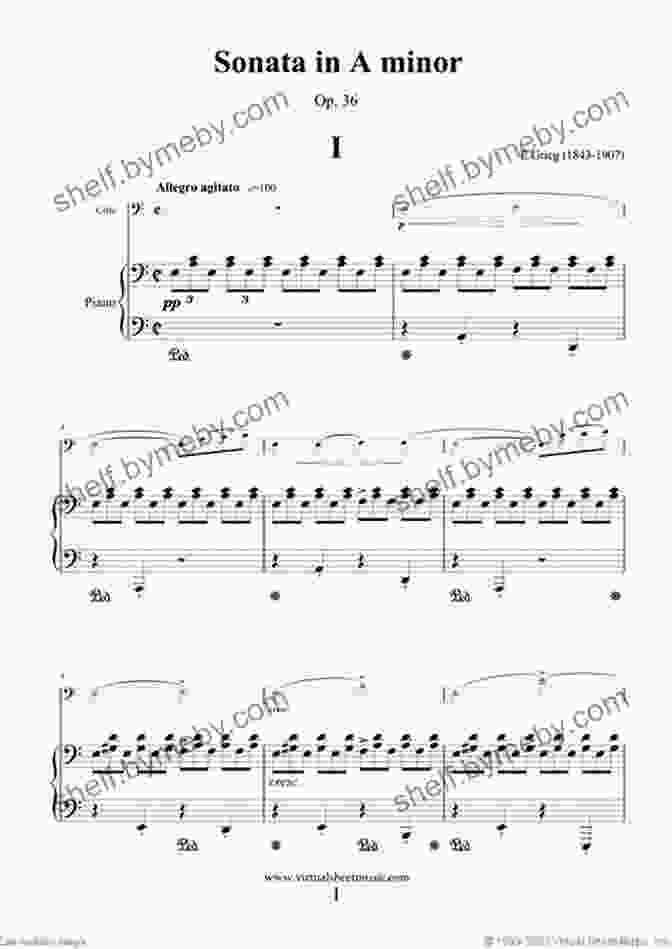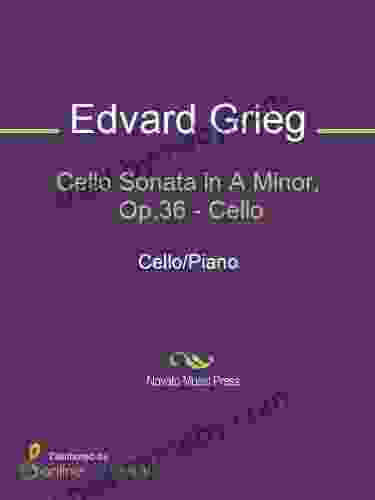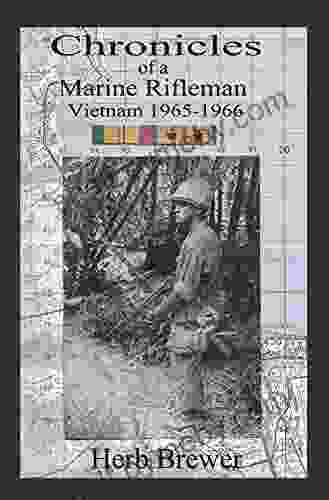Cello Sonata in G minor, Op. 36: A Masterpiece of Cello Literature


5 out of 5
| Language | : | English |
| File size | : | 4737 KB |
| Text-to-Speech | : | Enabled |
| Screen Reader | : | Supported |
| Enhanced typesetting | : | Enabled |
| Print length | : | 17 pages |
The Cello Sonata in G minor, Op. 36, is one of the most celebrated works for cello and piano in the classical music repertoire. Composed by Ludwig van Beethoven in 1808, it is a masterpiece of chamber music that showcases the expressive and virtuosic capabilities of the cello.
This article will delve into the history, structure, and musical significance of the Cello Sonata in G minor, Op. 36. We will explore its unique features, the challenges it presents to performers, and its enduring legacy in the cello repertoire.
History and Context
The Cello Sonata in G minor, Op. 36, was composed during a period of great personal and artistic growth for Beethoven. He had recently completed his Fifth Symphony, and he was exploring new and innovative approaches to music composition.
The sonata was dedicated to Baron Ignaz von Gleichenstein, a patron of the arts who had commissioned Beethoven to write a work for cello and piano. The first performance of the sonata took place in Vienna in 1809, with Beethoven himself performing the piano part.
Structure and Analysis
The Cello Sonata in G minor, Op. 36, is a four-movement work with the following structure:
- Allegro
- Adagio sostenuto ed espressivo
- Scherzo: Allegro molto
- Allegro
The first movement, Allegro, is in sonata form and begins with a dramatic and forceful theme in the cello. The development section is particularly elaborate, showcasing Beethoven's mastery of contrapuntal writing.
The second movement, Adagio sostenuto ed espressivo, is a lyrical and emotionally charged piece in ternary form. The cello melody is accompanied by a delicate and supportive piano part.
The third movement, Scherzo: Allegro molto, is a playful and energetic scherzo in ternary form. The cello and piano engage in a lively dialogue, with the cello providing a rhythmic and melodic foundation.
The fourth movement, Allegro, is a virtuosic and demanding finale in sonata form. The cello and piano engage in a thrilling and intricate interplay, culminating in a dramatic and triumphant .
Musical Significance
The Cello Sonata in G minor, Op. 36, is a significant work in the cello repertoire for several reasons:
- It showcases the expressive and virtuosic capabilities of the cello. The sonata demands a high level of technical skill from the cellist, with challenging passages that require precise intonation, articulation, and bow control.
- It is a masterpiece of sonata form. Beethoven's handling of sonata form in this work is exemplary, with a clear and logical development of themes and a satisfying sense of closure.
- It is a powerful and emotionally resonant work. The sonata's emotional range is wide, from the dramatic intensity of the first movement to the lyrical beauty of the second movement.
Challenges for Performers
The Cello Sonata in G minor, Op. 36, is a challenging work for both cellists and pianists. The cello part is particularly demanding, requiring a high level of technical skill and musical sensitivity.
The challenges for cellists include:
- The wide range of the cello part, which requires a cellist with a strong and flexible left hand.
- The intricate fingerwork and bowings, which require precise execution.
- The demands of the different movements, which range from the intense and dramatic first movement to the lyrical and expressive second movement.
The challenges for pianists include:
- The supportive and
5 out of 5
| Language | : | English |
| File size | : | 4737 KB |
| Text-to-Speech | : | Enabled |
| Screen Reader | : | Supported |
| Enhanced typesetting | : | Enabled |
| Print length | : | 17 pages |
Do you want to contribute by writing guest posts on this blog?
Please contact us and send us a resume of previous articles that you have written.
 Book
Book Novel
Novel Page
Page Chapter
Chapter Text
Text Story
Story Genre
Genre Reader
Reader Library
Library Paperback
Paperback E-book
E-book Magazine
Magazine Newspaper
Newspaper Paragraph
Paragraph Sentence
Sentence Bookmark
Bookmark Shelf
Shelf Glossary
Glossary Bibliography
Bibliography Foreword
Foreword Preface
Preface Synopsis
Synopsis Annotation
Annotation Footnote
Footnote Manuscript
Manuscript Scroll
Scroll Codex
Codex Tome
Tome Bestseller
Bestseller Classics
Classics Library card
Library card Narrative
Narrative Biography
Biography Autobiography
Autobiography Memoir
Memoir Reference
Reference Encyclopedia
Encyclopedia Simon Winchester
Simon Winchester Maria Coffey
Maria Coffey Susanne Foitzik
Susanne Foitzik Horace Kephart
Horace Kephart Homura Kawamoto
Homura Kawamoto Helena Reckitt
Helena Reckitt Ron Fortier
Ron Fortier Lauren Kahl
Lauren Kahl Hirohiko Araki
Hirohiko Araki Jomike Tejido
Jomike Tejido Kabir Sehgal
Kabir Sehgal Pass Your Class
Pass Your Class Saul Tanpepper
Saul Tanpepper Lucy Christopher
Lucy Christopher Peter Mark Adams
Peter Mark Adams Heather Lehr Wagner
Heather Lehr Wagner Paula Harrison
Paula Harrison Hezekiah Butterworth
Hezekiah Butterworth Henry Miller
Henry Miller Hayden Fox
Hayden Fox
Light bulbAdvertise smarter! Our strategic ad space ensures maximum exposure. Reserve your spot today!

 Bryce FosterThe Art and Life of Isamu Noguchi: A Timeless Master of Sculpture, Design,...
Bryce FosterThe Art and Life of Isamu Noguchi: A Timeless Master of Sculpture, Design,... Italo CalvinoFollow ·8.1k
Italo CalvinoFollow ·8.1k Gerald ParkerFollow ·6.1k
Gerald ParkerFollow ·6.1k Dawson ReedFollow ·16k
Dawson ReedFollow ·16k Wade CoxFollow ·11.8k
Wade CoxFollow ·11.8k Dylan MitchellFollow ·15.1k
Dylan MitchellFollow ·15.1k Ray BlairFollow ·17.2k
Ray BlairFollow ·17.2k Matthew WardFollow ·2.6k
Matthew WardFollow ·2.6k Fernando BellFollow ·14.5k
Fernando BellFollow ·14.5k

 Bo Cox
Bo CoxUncover the Enchanting Pearl of the Arabian Gulf: Insight...
Escape to the opulent...

 Michael Crichton
Michael CrichtonInsight Guides Pocket Baku Travel Guide Ebook: Your...
An Enchanting Journey...

 Eugene Scott
Eugene ScottLearn to Paint Scenic Scenes: Unveil the Secrets of...
Step into the...

 Benji Powell
Benji PowellEmbark on a Culinary Adventure with "The Ultimate Sichuan...
Sichuan cuisine,...

 Finn Cox
Finn CoxDiscover the Enchanting World of Art Nouveau: A...
Immerse yourself in the captivating beauty...

 Corey Green
Corey GreenUncover the Vibrant World of Guatemalan Chicken Buses: An...
Step into a world of vibrant colors,...
5 out of 5
| Language | : | English |
| File size | : | 4737 KB |
| Text-to-Speech | : | Enabled |
| Screen Reader | : | Supported |
| Enhanced typesetting | : | Enabled |
| Print length | : | 17 pages |










